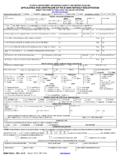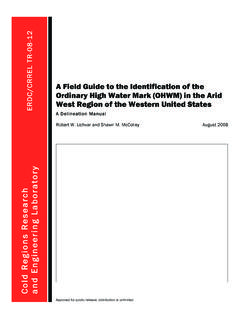Transcription of 47 Raptor Identification, 2 Ageing, and Sexing
1 WILLIAMS. CLARK2301 S. Whitehouse Circle, Harlingen, TX 78550 USATo successfully conduct Raptor research or, indeed, anyornithological research, researchers must be able toidentify their subjects accurately to species and, inmany studies, determine their age and sex. This is truefor (1) field studies, including observations and counts,(2) capture for ringing ( , banding), color marking,and radio tracking and telemetry, and (3) the examina-tion and measurement of museum is more difficult for Falconiformesthan for Strigiformes, as there are more species (morethan 300 Falconiformes versus about 200 Strigiformes)and more variation in plumages within species. Most ofthis chapter applies to diurnal raptors. The followingparagraphs discuss plumages, including field marks andunusual plumages; field guides, with cautions abouttheir use; the use of molt as a tool in ageing; the use ofbehavior in field identification ; and a section on identi-fication in the hand.
2 Important references are listed atthe end of the POINTERSA ccurate identification is CriticalThe validity of the results and conclusions of any raptorresearch depends upon the accurate identification of thesubjects involved. Therefore, workers must acquire orsharpen their skills in species identification , includingsexing and ageing, to produce the best research. Fortu-nately, for some researchers, good bird field guides,often including field and photo guides specifically forraptors, as well as an ever-growing list of published arti-cles on identification , ageing, and Sexing of raptors, arereadily Are Raptors Difficult to Identify?Diurnal raptors are difficult to identify because mostspecies have a variety of plumages, including differentplumages for immatures, sexes, and color morphs; andmany exhibit considerable individual variation. Manyof these plumages are similar to those of other cause of difficulty is that many bird fieldguides don t show the range of variation in plumages,don t include the latest information regarding importantfield marks, and don t portray the shapes of flying andperched raptors accurately.
3 This is true even in an erawith access to many wonderful and Photographic EquipmentWe now have better binoculars, telescopes, and camerasto aid our Raptor research. Although some researchersare not able to afford top-of-the-line equipment, lowerpriced equipment is often very good and adequate formost research needs. Thus, researchers are able to getmuch better views of their subjects and use more subtlefield marks to identify them and determine age and , we can take high-quality photographs of raptors,especially in those cases where the identification couldnot be made in the field. Raptor researchers are urged to47 Raptor Identification, Ageing, and Sexing2always bring their cameras in the field with them so thatthey can photograph raptors of questionable identifica -tion for later verification . More than once, I havechanged the identification of a Raptor after viewing pho-tographs of them IDENTIFICATIONThe topics below should be read and studied to betterunderstand how to identify raptors correctly under TerminologyUse of proper age terminology helps us to understandmolt, plumages, and ageing.
4 The best age terminologyis one that corresponds one-to-one with annual changesin plumage; those that change with the calendar year areconfusing because the age of the bird changes on 1 Jan-uary, but the bird does not change in begin with two sets of down, descriptionsof which are not within the scope of this chapter. Whilestill in the nest, young raptors acquire their first, orjuvenal plumage (note that the spelling is juvenalplumage in North America and juvenileplumage else-where). In most species, juvenal plumage is worn for 7months to almost a year. In temperate regions, raptorstypically fledge in summer and begin the molt fromtheir juvenal plumage into their second plumage thenext spring. In tropical areas, this molt usually begins 8or 9 months after fledging, which can be at any monthof the year depending on the timing of breeding and isusually determined by the timing of regional wet anddry on the size of the Raptor , annual molttakes between 3 and 10 months to complete.
5 In somespecies, usually the smaller ones, the resulting plumageis the adult or Definitive Basic plumage (Humphrey andParks 1959). Most falcons have only one immature orjuvenal plumage. Many accipitrid raptors, especiallylarger buzzards, vultures, and eagles, however, havemore than one immature plumage. In North America,the latter immature plumages are called Basic I, thenBasic II, etc. until Definitive Basic (Adult) plumage isachieved (Humphrey and Parks 1959). Howell et al.(2003) refers to the latter immature plumages as BasicII, Basic III, etc. In other geographic areas, most callthem Second plumage, Third plumage, etc. The secondand subsequent plumages are acquired by annual that many field guides and authors use the termimmature for juvenile. The term subadult has been usedto refer to at least three different age categories. The useof subadult should be MarksField marks are the characters of a bird, in our case, araptor, that can be used by the observer to identify it tospecies and, often, its age and sex.
6 Field marks includeplumage characters such as the white head and tail ofadult Bald Eagles (Haliaeetus leucocephalus), the widewhite line running through the underwings of immatureSteppe Eagles (Aquila nipalensis), or the bold black-and-white plumage of adult male Pied Harriers (Circusmelanoleucus). For most raptors, more than one fieldmark is needed for identity, and the more field markscorrectly seen, the more certain the identity. Other fieldmarks are the shape and length of wings and tail onsoaring raptors (Fig. 1), head projection beyond thewings on flying raptors, and, for many species, the posi-tions of the wing tip relative to the tail tip on perchedraptors (Fig. 2). Wing attitude of soaring and glidingraptors also can be field marks, along with behavior pat-terns, such as kiting and hovering or the wing flex ofvultures.
7 Some field marks, such as pale wing panels,are useful only on flying individuals, whereas the colorof the shoulders can apply only to perched Guides Field guides, especially Raptor field guides and photoguides, are one of the best sources for field marks usedto identify raptors in the field. Unfortunately, many ofthe general bird guides are inadequate for raptors,although they are useful for most other species of guides often contain errors in age and sex charac-teristics, fail to show the range of variation in plumages,and incorrectly depict the shape of flying and perchedindividuals. That said, some of the newer bird fieldguides, including Hollom et al. (1988), Fjelds andKrabbe (1990), Jonsson (1993), Zimmerman et al.(1996), Mullarney et al. (1999), Sibley (2000), and Ras-mussen and Alderton (2005), depict wing and tailshapes correctly, and their perched raptors look liketheir real-life subjects.
8 Additional general bird guides,including Barlow and Wacher (1997), Grimmett et al.(1999), and Stevenson and Fanshawe (2002), adequate-ly describe plumage and field marks, but don t depictwing, tail, and body shapes identification , AGEING, AND SEXINGOn the other hand, many Raptor guides vary fromvery good to excellent. The very first field guide toshow accurate wing and tail shapes in flight was FlightIdentification of European Raptors(Porter et al. 1981).The authors, including the artist, are to be commendedfor this classic work. Although this guide is somewhatout of date, does not include perched raptors, and hasonly black-and-white drawings and photos, it is highlyrecommended. Following the lead of Porter et al.(1981), other Raptor field and photo guides includeWheeler and Clark (1995), Morioka et al. (1995),DeBus (1998), Forsman (1999), Clark (1999a), Clarkand Wheeler (2001), Coates (2001), Wheeler (2003a,b),and Ligouri (2005).
9 Two other photo guides with goodphotos, but little information are Allen (1996) andKemp and Kemp (1998).The two most recent global handbooks for raptors,del Hoyo et al. (1994) and Ferguson-Lees and Christie(2001), have some information on Raptor Identification, but their illustrations were produced primarily frommuseum specimens, often with simplistic cookie cut-ter wing and body shapes that don t resemble theirreal-life counterparts. The new world Raptor field guideby the latter authors (Ferguson-Lees and Christie 2005)uses most of the same museum-specimen plates. Sever-al continental handbooks, including Cramp and Sim-mons (1980) for Europe, Palmer (1988) for NorthAmerica, and Marchant and Higgins (1993) for Aus-tralia, contain much information and useful illustrationson Raptor important sources of information for fieldidentification include the many articles on the subjectthat have appeared in the peer-reviewed are too many of these to list all of them, butexamples include Watson (1987), Brown (1989), Clarkand Wheeler (1989, 1995), Clark et al.
10 (1990), Shirihaiand Doherty (1990), Clark and Schmitt (1993, 1998),Clark and Shirihai (1995), Debus (1996), Forsman(1996a,b), Alstr m (1997), Forsman and Shirihai(1997), Corso and Clark (1998), Clark (1999b), Corso(2000), and Rasmussen et al. (2001).Methods of FlightRaptors use one of four methods for flying. Recogniz-ing which method they are using is important in identi-fication. Raptors soar to gain altitude in rising air, usu-ally in a thermal or a deflection updraft. When soaring,their wings are spread to the maximum with outer pri-maries often recognized as fingers and often with wristsRAPTOR identification , AGEING, AND SEXING49 Figure Verreaux s Eagle (Aquila verreauxii). Wing shape isan important field mark, as shown on this African eagle. ( Clark, Kenya)Figure Peregrine Falcon (Falco peregrinus). In the Americas,the Peregrine Falcon is the only falcon that, when perched, showswingtips reaching the tail tip.




